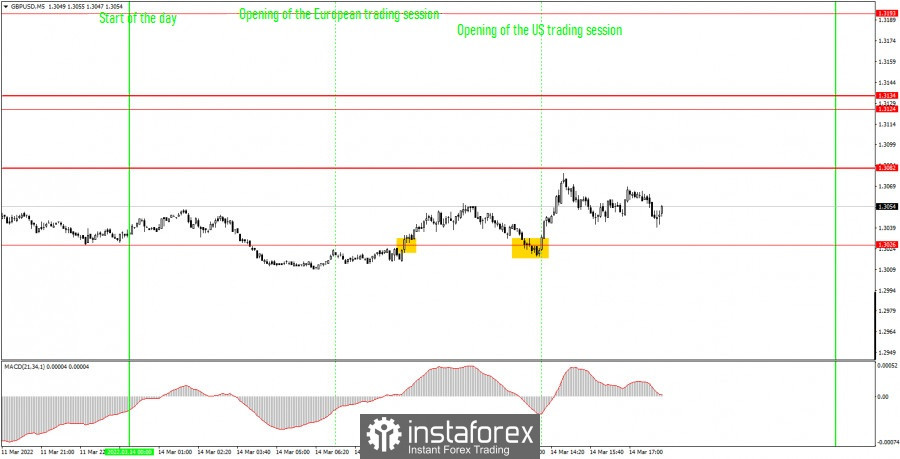Analysis of previous deals:
30M chart of the GBP/USD pair

The GBP/USD pair did not move in the worst way on Monday. Better than Friday. As in the case of the European currency, a correction to the downward trend line began, but the price failed to reach it by the end of the day. Thus, the downward trend continues, and the fall of the British pound can resume at any moment. Strong sell signals today or tomorrow may be rebounds from the level of 1.3082 or the trend line. In general, the British pound is quite low now, but one should understand how it got here. The fall followed after the military conflict between Ukraine and Russia began on February 24. Since this conflict is not over, the pound can resume to fall at any moment. However, there will be more important events for the GBP/USD pair this week. For example, meetings of the Federal Reserve and the Bank of England, where key rates are likely to be raised. Meetings are scheduled for Wednesday and Thursday, but the market may start to work out possible results well in advance. Therefore, the volatility tomorrow may be quite high.
5M chart of the GBP/USD pair

The technical picture on the 5-minute timeframe is pretty good. There were only two trading signals during the day, and both are quite accurate. It is unlikely that novice traders managed to earn a lot, but they still managed to do something. The first buy signal was formed when the price broke 1.3026 (Friday's low). After this signal, the pair managed to go up about 20 points, so at least traders had to set Stop Loss to breakeven. It was for this Stop Loss that the long position was closed as a result. This was followed by another buy signal near the level of 1.3026 in the form of a rebound. This time the price went up about 40 points and just a little did not reach the level of 1.3082. However, this time the pair did not return back to the level of 1.3026, and the long position should have been closed in any case. Thus, in any case, it would have made a profit. In sum, we did not have the best day, few signals, rather weak volatility (only 70 points), but still at least one profitable trade.
How to trade on Tuesday:
The pair continues to trade down on the 30-minute timeframe, and the downward trend is already quite strong and long. As long as the pair does not settle above the trend line, we do not expect a strong growth from the British currency. And even if it consolidates, it may be a false end to a downward trend. The thing is that the fundamental background currently remains on the dollar's side, but maybe everything will change on Wednesday and Thursday. On the 5-minute TF tomorrow it is recommended to trade at the levels of 1.2913, 1.3026, 1.3082, 1.3124-1.3134, 1.3193. When the price passes after opening a deal in the right direction for 20 points, Stop Loss should be set to breakeven. Tomorrow the UK is set to release important reports on unemployment, jobless claims and wages. However, with two major central bank meetings on Wednesday and Thursday, we believe these reports will be ignored. There are no important events scheduled in America for tomorrow.
Basic rules of the trading system:
1) The signal strength is calculated by the time it took to form the signal (bounce or overcome the level). The less time it took, the stronger the signal.
2) If two or more deals were opened near a certain level based on false signals (which did not trigger Take Profit or the nearest target level), then all subsequent signals from this level should be ignored.
3) In a flat, any pair can form a lot of false signals or not form them at all. But in any case, at the first signs of a flat, it is better to stop trading.
4) Trade deals are opened in the time period between the beginning of the European session and until the middle of the American one, when all deals must be closed manually.
5) On the 30-minute TF, using signals from the MACD indicator, you can trade only if there is good volatility and a trend, which is confirmed by a trend line or a trend channel.
6) If two levels are located too close to each other (from 5 to 15 points), then they should be considered as an area of support or resistance.
On the chart:
Support and Resistance Levels are the Levels that serve as targets when buying or selling the pair. You can place Take Profit near these levels.
Red lines are the channels or trend lines that display the current trend and show in which direction it is better to trade now.
The MACD indicator (14,22,3) consists of a histogram and a signal line. When they cross, this is a signal to enter the market. It is recommended to use this indicator in combination with trend lines (channels and trend lines).
Important speeches and reports (always contained in the news calendar) can greatly influence the movement of a currency pair. Therefore, during their exit, it is recommended to trade as carefully as possible or exit the market in order to avoid a sharp price reversal against the previous movement.
Beginners on Forex should remember that not every single trade has to be profitable. The development of a clear strategy and money management are the key to success in trading over a long period of time.
 English
English 
 Русский
Русский Bahasa Indonesia
Bahasa Indonesia Bahasa Malay
Bahasa Malay ไทย
ไทย Español
Español Deutsch
Deutsch Български
Български Français
Français Tiếng Việt
Tiếng Việt 中文
中文 বাংলা
বাংলা हिन्दी
हिन्दी Čeština
Čeština Українська
Українська Română
Română

